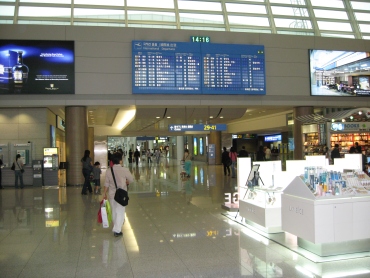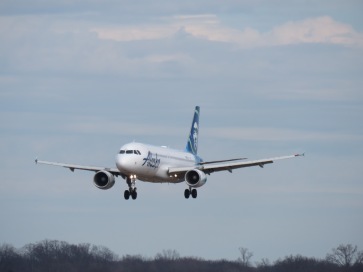 According to a quick Google search, Pittsburgh International Airport saw around 9 million passengers in 2018. Chicago Midway had 22 million. Tampa had around 21 million. My airport saw just over 8 million passengers – the most ever. That’s great! Or is it? How does an airport know whether the number of passengers they are serving is good or not?
According to a quick Google search, Pittsburgh International Airport saw around 9 million passengers in 2018. Chicago Midway had 22 million. Tampa had around 21 million. My airport saw just over 8 million passengers – the most ever. That’s great! Or is it? How does an airport know whether the number of passengers they are serving is good or not?
Load factors
One useful metric is the load factor. You may have seen this used to determine how well an airline is performing in general, but in this case airports are looking specifically at the load factors for flights into and out of their cities. In the simplest sense, the load factor is a measure of how full the flights are. It is calculated by comparing the number of paying passengers against the total number of seats that were available. For example, if ABC Airlines had 5 flights in and 5 flights out of the airport and used airplanes with 100 seats each, that’s a total of 1,000 seats available. If each plane had 75 paying passengers on board, then there were 750 passengers total, and the load factor is 75%.
 I can’t speak to how other airports collect passenger data, but my airport does it via monthly reports that are submitted by the airlines. Each report includes the type of planes used, the number of landings for each, the number of passengers, etc. From that information we can determine the total number of seats and, in turn, calculate the load factors for each airline, as well as an average load factor for all flights during the month.
I can’t speak to how other airports collect passenger data, but my airport does it via monthly reports that are submitted by the airlines. Each report includes the type of planes used, the number of landings for each, the number of passengers, etc. From that information we can determine the total number of seats and, in turn, calculate the load factors for each airline, as well as an average load factor for all flights during the month.
Higher load factors mean fuller airplanes which means better profit margins for the airlines. When flights aren’t profitable guess what usually happens? Yep – they go away. Not good! While the monthly load factors are useful, it is also important to look at trends over time. Comparing the numbers from the last few years I noticed that the average monthly load factor at my airport has increased more than 5% – and it was fairly strong to begin with. We definitely like to see that!

Photo by Jnpet, Creative Commons License
Heavier metal
Of course load factors are just one piece of the story. Another metric to look at is the types of planes that are being used, and how that usage shifts over time. A high load factor on a small plane is good. But when the number of passengers becomes strong enough to justify moving up to a bigger airplane, that’s better. And when the load factors start growing on the bigger airplane, that’s better still!
Let’s take the humble CRJ for example. To keep it simple I’ll combine the stats for the 200, 700 and 900 together. In February 2019 there were roughly 100 fewer CRJ landings than in February 2018. However, there were 100 more Airbus 319/320 landings, and 50 more Boeing 737 landings. Some of those increases were due to added flights and Mad Dogs being retired, but many were the result of a shift to bigger mainline planes and fewer regional ones. That comes out to several thousand more seats available in February 2019 vs 2018. At the same time, the load factors remained strong. Yes! That makes us very happy! (Don’t you worry – we still love the CRJ! Although the number of flights may have decreased, we still see PLENTY of them around.)
 Max effect
Max effect
You may be wondering what kind of impact the grounding of the Boeing 737 Max is having on all this. That’s a fairly complex matter. Certainly there have been some cancellations. Looking just at the airlines that fly the Max into my airport and comparing the number of flights that were scheduled against the number of flights that actually happened, there was a drop of about 3%. That may not seem like a high number, but then again, that was just for half the month. It remains to be seen what the long term implications will be. If you are curious to know how an airline copes when some of its planes are grounded, the Flying and Life Podcast gave a really good overview of what steps they have to take to re-book stranded passengers and rework their schedules. I strongly encourage you to check it out!
Lies, Damn Lies and…
The numbers are, of course, just a snapshot in time and there are a whole lot of factors that the airlines consider when deciding which planes to fly on what routes. Things can change from month to month and season to season. That’s why the airport has people much smarter than myself who track and analyze all this data. But every now and then I like to take a peek and see how things are looking. Maybe one of these days I’ll see an A350 on the stats sheet. Or a 777! OK, so it’s not very likely. But, hey – an avgeek can dream!

Not an airliner. I just couldn’t resist adding a pic of this sweet bizjet!
Thanks for another interesting article,
LikeLike
Thanks for reading, Fred!
LikeLike
I just thought of an interesting blog for you. I live in the state of IL. I saw an add on tv from the IL Secretary of State. (A lot of states call this the DMV) around March 29, 2019. They said that as of October 1st 2020 you will need a REAL ID in order to board a plane, enter a military base or secure federal facilities. Your current Drivers License or ID Card will no longer be valid to get through TSA at any airport. This includes flying anywhere in the United States. As of April 1st 2019 you can go to the IL Secretary Of State office and apply for a new DL/ID card.If you have a current Passport a REAL ID will not be needed. People will need to visit the SOS site and see what proof of ID they need to bring with them to obtain a REAL ID.
I went and applied on April 11th and got my new REAL ID on April 22nd. I have mentioned this to many friends etc.and I have yet to have one say that they have heard of this. TSA had been giving the State of IL a pass for having this new system for around the last 5 years.
Does the state you live in have something like this already in place?
Wondering how many states already have this in place and how many do not.
LikeLike
Hi Fred! My state is also implementing the REAL ID. I think all states will be required to have it. From what I can tell, people find out about it when they get their annual notice to renew their registrations/licenses (as opposed to any kind of major advertising campaign). For now I am choosing instead to renew my passport. But maybe I’ll get the ID at some point too.
LikeLike
My Illinois DL was not set to expire until November 2021. IL DL’s are for 4 years until you need a new one.
LikeLike
Is dat an ‘Awker Miss?
Great analysis Jen but I’m curious how your upward trend compares with the overall rise in demand in the States. Are you ahead of the growth curve?
LikeLike
Thanks for reading, Nick! And good question. I believe that we are but I’d have to do some digging to confirm. Being in one of the fastest-growing cities in the country certainly helps.
LikeLike